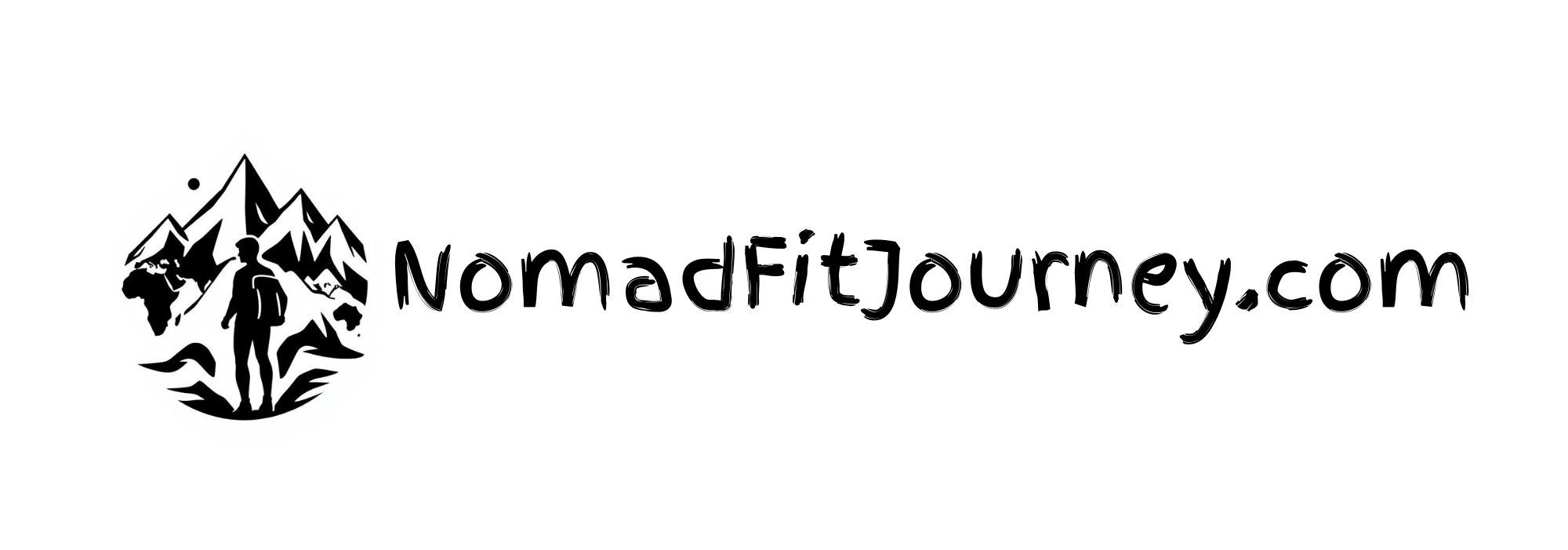Incorporating stretching and mobility routines during your workday can boost productivity and reduce discomfort from prolonged sitting. Try desk stretches like neck tilts and shoulder rolls to relieve tension. Engage in upper body mobility exercises, like scapular retraction, and lower back stretches, such as seated forward bends. Include hip openers and standing stretches to energize your work routine. Don’t forget wrist and hand exercises to enhance mobility. Discover uncomplicated techniques to create a personalized stretching routine that fits your day seamlessly.
Nomad Highlights
- Incorporate neck tilts and chin tucks to relieve tension and improve posture during long hours at the desk.
- Utilize simple desk yoga poses like seated figure-four and standing hip flexor stretches to enhance flexibility and reduce tightness.
- Schedule hourly stretching breaks to target key areas such as the neck, shoulders, and lower back for consistent relief.
- Perform wrist and hand exercises, including finger stretches and wrist flexion, to alleviate discomfort from typing and mouse use.
- Integrate deep breathing techniques like the 4-7-8 method to enhance focus and promote relaxation during work transitions.
Benefits of Stretching During Work Hours
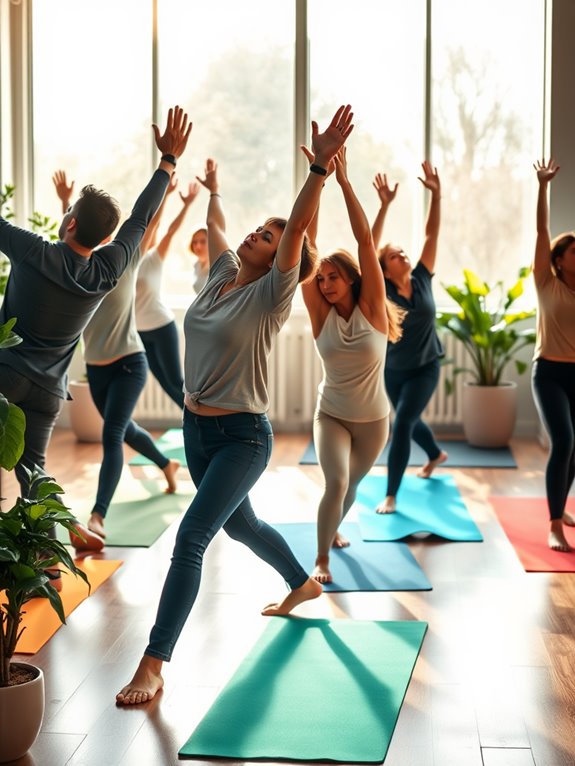
While you might think that staying glued to your desk is the best way to get work done, incorporating stretching into your workday can actually boost your productivity. The stretching benefits extend beyond mere physical relief; they enhance your mental clarity and focus. When you take short breaks to stretch, you increase blood flow and oxygen to your brain, helping you tackle tasks with renewed energy. Additionally, engaging in unique products related to wellness can help you discover new ways to enhance your stretching routine. This practice promotes workplace wellness, reducing stress and preventing injuries associated with prolonged sitting. In fact, studies have shown that regular breaks can significantly improve overall job performance. In addition, regular stretching fosters a positive work environment, encouraging collaboration and creativity. Incorporating tools like ankle resistance bands can further enhance your stretching routine by providing effective resistance training. Furthermore, using collapsible foam rollers during breaks can effectively target muscle pain and enhance recovery, making them a great addition to your wellness toolkit. These compact foam rollers are designed for portability, allowing you to easily integrate muscle relief into your workday.
Desk Stretches for Neck and Shoulders

If you’ve ever felt tension building in your neck and shoulders while working at your desk, you’re not alone. Incorporating simple neck stretch techniques and shoulder mobility exercises can make a big difference in your comfort and productivity. Ergonomic chairs with adjustable features can further enhance your sitting experience, allowing you to maintain proper posture while performing these stretches. Regularly performing stretches can improve blood circulation, which is essential for reducing muscle tightness and enhancing overall wellness. Additionally, utilizing fitness trackers can help you monitor your health metrics throughout the day, ensuring you stay aware of your overall wellness. Using tools like a stretching strap can provide enhanced flexibility and support during your desk stretches, making them more effective. Ergonomic designs in writing tools can also aid in reducing discomfort during long writing sessions. Let’s explore some quick stretches you can do right at your workstation to relieve that tightness.
Neck Stretch Techniques
Neck stretches are essential for countering the tension that builds up during long hours at your desk.
Start with a simple neck tilt: gently lower your ear towards your shoulder, holding for 15-30 seconds on each side. This helps alleviate neck tension and promotes muscle relaxation. Incorporating adjustable footrests into your workspace can also enhance comfort by improving posture.
Next, try the chin tuck—pull your chin back, aligning your ears with your shoulders, and hold for a few seconds. This exercise strengthens the neck muscles and improves posture.
Finally, perform gentle neck rotations, moving your head in a circular motion to release tightness.
Incorporating these techniques throughout your workday can enhance your comfort and productivity, ensuring you stay focused and energized. Additionally, consider using stress balls as a simple stress relief tool to help manage anxiety during your work hours.
Shoulder Mobility Exercises
To keep your shoulders flexible and reduce tension during long hours at your desk, incorporating shoulder mobility exercises into your routine is essential.
Start with shoulder rolls: lift your shoulders toward your ears, roll them back, and then drop them down. Repeat this several times to release tightness. Regular movement can also help reduce reliance on single-use plastics, contributing to a cleaner environment.
Next, practice scapular retraction by sitting up straight and squeezing your shoulder blades together, holding for a few seconds before releasing. This not only improves your posture but also enhances mobility. Incorporating these exercises can complement the benefits of using an ergonomic lapstand to promote better posture and reduce discomfort. Additionally, using an adjustable tablet stand can provide optimal viewing angles that further support shoulder health and encourage better alignment. Using an ergonomic wrist rest can additionally prevent wrist pain and enhance overall comfort during your workday. Resistance bands can also be a great tool for adding strength training to your routine, which further supports shoulder health.
You can perform these exercises throughout your workday, making them easy to integrate into breaks or meetings.
Upper Body Mobility Exercises
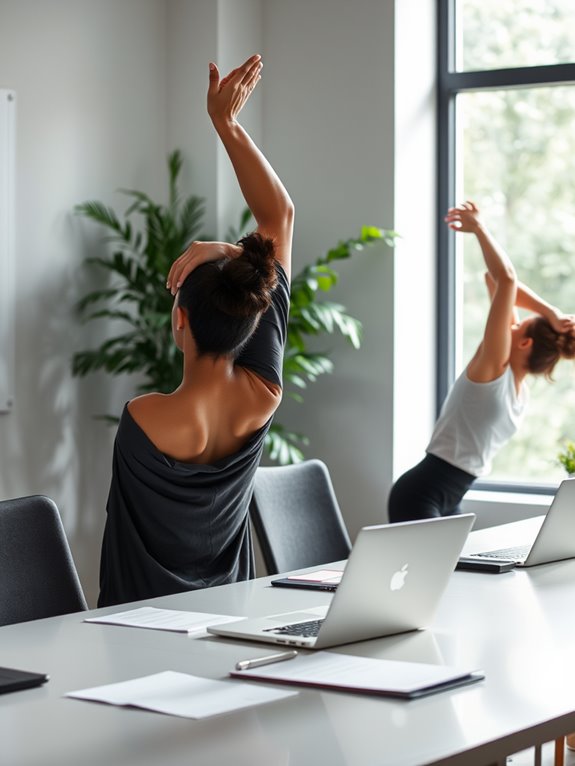
While you may spend long hours at your desk, incorporating upper body mobility exercises can greatly enhance your comfort and productivity.
Start with upper back stretches to relieve tension and improve posture. Try clasping your hands together, extending your arms in front, and rounding your upper back. Hold for 15-30 seconds.
Next, focus on chest stretches. Stand up, place your hands on your hips, and gently pull your elbows back, opening up your chest. This counteracts the forward hunch from sitting. Resistance bands can also be used to enhance upper body exercises and provide additional support for stretching. Incorporating stretching straps into your routine can further improve flexibility and assist in achieving deeper stretches.
Incorporate these simple movements every hour to boost circulation and flexibility. You’ll feel energized and ready to tackle your tasks with renewed focus. Additionally, consider using essential oils to create a calming atmosphere while you stretch, enhancing your overall well-being.
Lower Back Stretches to Relieve Tension
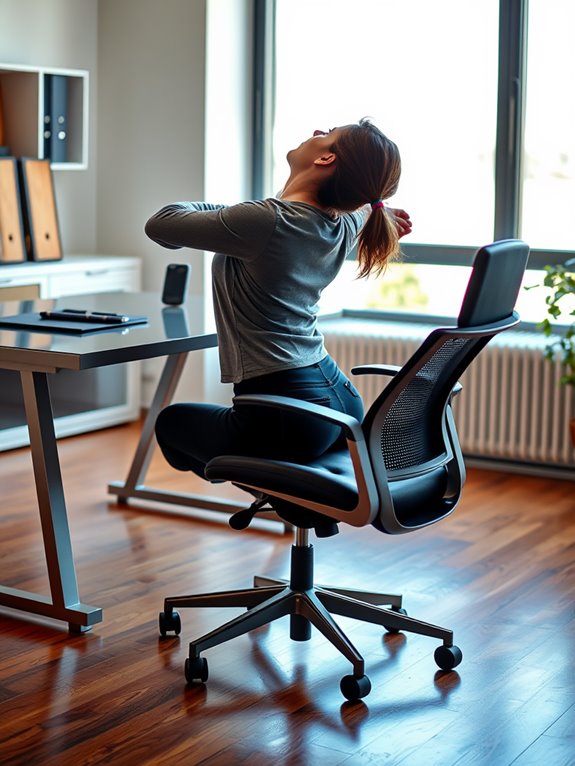
If you find yourself experiencing discomfort in your lower back after hours of sitting, incorporating targeted stretches can make a world of difference.
Start with the seated forward bend: while sitting, reach for your toes, allowing your back to round gently. This stretch promotes tension relief by elongating your spine. Additionally, using a chair with ergonomic designs can further enhance your comfort while working, as ergonomic chairs are specifically designed to support your posture. Regularly integrating compact air purifiers into your workspace can also improve air quality, contributing to overall well-being. Cloud storage solutions often emphasize the importance of user-friendly interfaces for efficient file management, similar to how ergonomic tools improve comfort.
The seated forward bend helps relieve tension and elongate your spine, providing comfort during long hours of sitting.
Next, try the standing side bend; raise one arm and lean to the opposite side, creating space in your lower back.
Another effective stretch is the cat-cow; on all fours, alternate between arching and rounding your back to release tightness.
Finally, the child’s pose is excellent for relaxation and tension relief. Additionally, consider using an acupressure mat with over 11,000 acupressure points to further enhance relaxation and alleviate muscle tension during your breaks.
Integrating these stretches into your work routine can enhance your productivity and overall well-being.
Hip Openers for Improved Flexibility
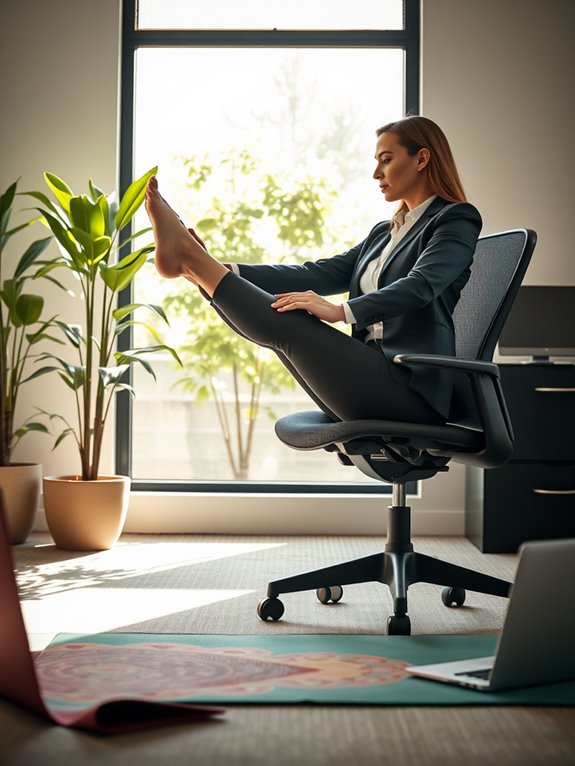
Hip openers are essential for enhancing flexibility and easing tightness, especially if you spend long hours sitting. You can easily incorporate simple desk exercises into your routine to keep your hips limber and reduce discomfort. Incorporating suspension training kits can also help improve your overall flexibility and strength during your stretching sessions. Additionally, using exercise sliders can effectively engage your core while performing hip-opening movements, enhancing both flexibility and stability. Regular use of compact foam rollers can further aid in relieving muscle tension and improving blood circulation during your stretching sessions, providing an effective way to support muscle tension relief. Taking regular movement breaks not only boosts your productivity but also promotes overall well-being. Incorporating resistance bands into your routine can further aid in improving strength and flexibility during your stretching sessions.
Benefits of Hip Openers
When you incorporate hip openers into your routine, you can greatly enhance your flexibility and overall mobility. This practice not only helps you feel more agile but also offers several specific benefits:
- Increased Hip Flexibility: Regularly engaging in hip openers can greatly improve your range of motion, making daily activities easier.
- Reduced Tension: Loosening tight hips alleviates discomfort, especially after long hours of sitting, enhancing your comfort throughout the day.
- Enhanced Mobility Improvement: As your hips become more flexible, you’ll notice better movement patterns in various exercises, increasing your performance. Additionally, using a non-slip surface during your practice can enhance safety and focus, making hip openers more effective.
Simple Desk Exercises
Incorporating just a few simple desk exercises can greatly enhance your hip flexibility, making your workday more comfortable and productive. These exercises can be complemented by unique products that promote better posture and comfort while working. Additionally, using ergonomic tools can further support your body’s natural alignment during long hours at your desk.
Start with desk yoga by sitting tall and gently bringing one knee toward your chest, holding for 15-30 seconds. Switch legs and repeat.
For a quick stretch, try the seated figure-four pose: cross one ankle over the opposite knee, then lean forward slightly to deepen the stretch. This stretch is similar to anti-glare technology used in screen protectors that helps reduce distractions during work.
Another effective move is the standing hip flexor stretch; stand, step one foot back, and bend your front knee while keeping your back leg straight.
These quick stretches will help relieve tightness and refresh your focus, allowing you to tackle your tasks with renewed energy and improved mobility throughout the day. Additionally, just as compact designs enhance portability in first aid kits, these desk exercises can be easily integrated into your daily routine without requiring much space or time.
Incorporating Movement Breaks
Taking just a few moments for movement breaks can greatly enhance your hip flexibility and overall comfort during the workday.
Incorporating these movement strategies into your routine will help you stay agile and focused. Use these break reminders to get started:
- Seated Figure Four Stretch: While sitting, place one ankle on the opposite knee, gently pressing down for a deep stretch.
- Lateral Leg Swings: Stand up and hold onto your desk for balance. Swing one leg side to side to open up your hips.
- Hip Circles: Stand tall and make circles with your hips, both clockwise and counterclockwise, to improve mobility.
Standing Stretches to Energize Your Workday

While sitting at your desk for hours can drain your energy, integrating standing stretches into your workday can revitalize your body and mind.
Try a simple workday stretch: stand tall, reach your arms overhead, and lean gently to one side, then the other. This movement boosts circulation and enhances flexibility.
Another effective standing energy booster is the calf stretch; just step back with one foot and press your heel into the ground. Hold for 15-30 seconds, then switch sides.
These quick routines not only break the monotony of desk work but also keep your muscles engaged and your mind sharp.
Incorporating these standing stretches can transform your workday, leaving you feeling refreshed and ready to tackle any challenge.
Wrist and Hand Exercises for Desk Workers
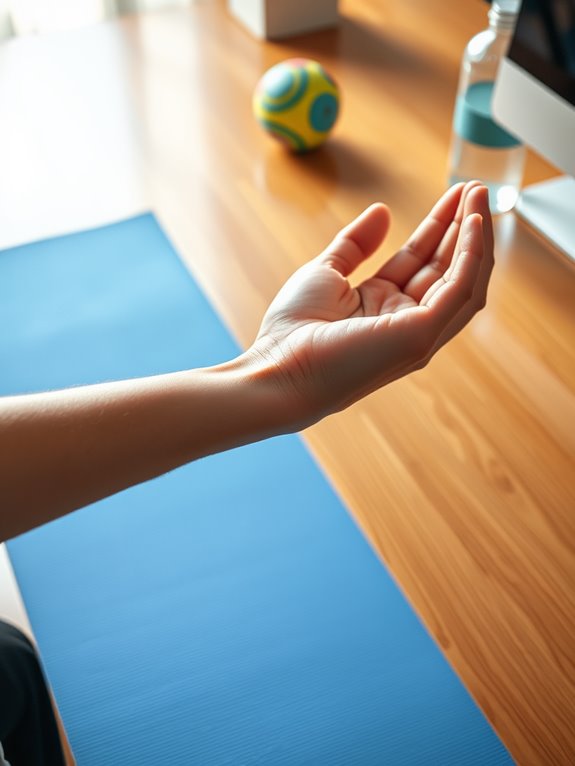
As you type away at your desk, it’s easy to neglect your wrists and hands, leading to discomfort or strain over time.
To keep them healthy and agile, try these simple exercises:
- Wrist Flexion: Extend one arm in front, palm up. With your other hand, gently pull back on your fingers, holding for 15 seconds. Switch hands and repeat.
- Hand Extension: With both arms extended, spread your fingers wide, then clench your fists tightly. Alternate between these positions for 10 repetitions.
- Finger Stretch: Interlace your fingers, then push your palms away from your body, feeling the stretch in your wrists and hands. Hold for 20 seconds.
Incorporating these exercises into your work routine can greatly reduce tension and improve mobility!
Incorporating Breathing Techniques for Relaxation
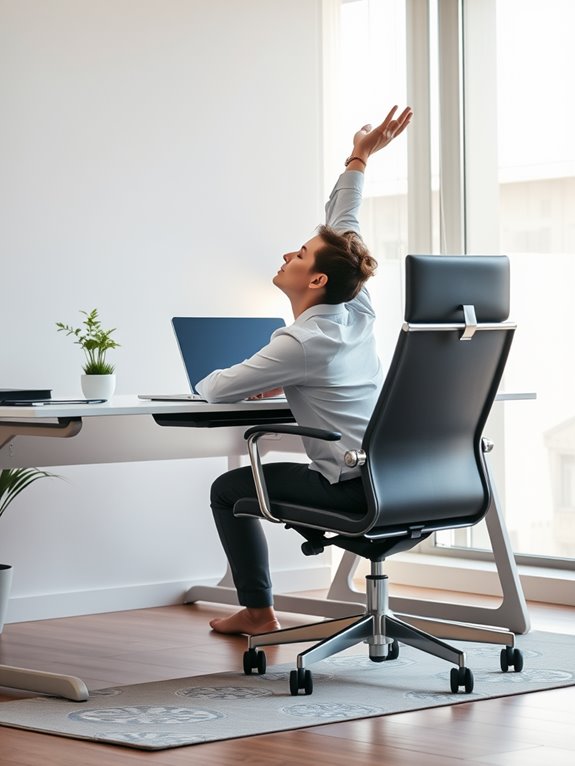
Breathing techniques serve as a powerful tool for relaxation, especially during long hours at your desk. By incorporating simple methods like deep diaphragmatic breathing, you can greatly reduce stress and increase focus.
Start by inhaling deeply through your nose for a count of four, holding for four, then exhaling through your mouth for another four counts. Repeat this cycle several times. You might also try the 4-7-8 method, which promotes calmness by extending the exhale.
These relaxation methods can be seamlessly integrated into your work routine; take a moment between tasks to ground yourself. Not only will you feel more centered, but you’ll also enhance your overall productivity.
Make these breathing techniques a habit, and watch your stress levels drop!
Creating a Daily Stretching Routine
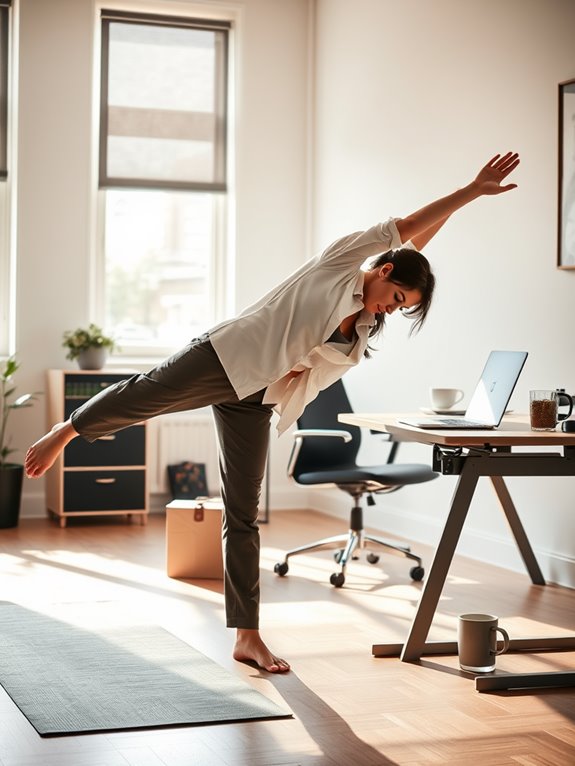
To maintain flexibility and prevent stiffness during your workday, creating a daily stretching routine is essential. Here’s how to get started:
- Set Daily Reminders: Use your phone or calendar to prompt you for stretching breaks every hour. Consistency is key!
- Choose Key Stretches: Focus on areas that often tighten, like your neck, shoulders, and lower back. Simple stretches can be highly effective.
- Incorporate Variety: Mix up your routine to keep it engaging. Try different stretches or add mobility exercises to prevent boredom.
Frequently Asked Questions
How Often Should I Stretch During My Workday?
You should aim to stretch every hour during your workday.
Each stretch session can last about 5 minutes, focusing on different muscle groups. This stretch frequency keeps your body energized and reduces tension, enhancing your overall productivity.
Remember, short breaks for stretching can prevent stiffness and improve your posture.
Listen to your body; if you feel tightness, don’t hesitate to take a moment to stretch it out. Your muscles will thank you!
Can Stretching Improve My Focus and Productivity?
Imagine your mind as a finely tuned instrument, needing occasional adjustments to hit the right notes. Stretching can spark focus enhancement and deliver a productivity boost like a refreshing change.
When you take a moment to stretch, you’re not just loosening your muscles; you’re energizing your brain, clearing mental fog, and sharpening your concentration.
What Are Signs I Need to Stretch More?
If you’re experiencing muscle tension or notice posture issues, it’s a clear sign you need to stretch more.
You might feel tightness in your shoulders or lower back after sitting for long periods. If your flexibility decreases or you struggle with everyday movements, those are also indicators.
Regular stretching can help alleviate discomfort, improve your posture, and boost your overall productivity.
Listen to your body; it’s telling you to take a break and stretch!
Are There Stretches Safe for Pregnant Workers?
If you’re pregnant and looking to safe stretches, it’s crucial to reflect on your body’s changing needs.
Focus on gentle movements like neck rolls, seated side bends, and simple hip openers. Always listen to your body and avoid overstretching.
Consulting with your healthcare provider can help tailor a routine that fits your pregnancy considerations. Staying active can ease discomfort, so find stretches that feel good and support your overall well-being during this special time.
How Can I Remind Myself to Stretch Regularly?
You’d think your body’s gonna explode if you don’t stretch!
To remind yourself to stretch regularly, set up stretching reminders on your phone or use mobile apps designed for this purpose.
These apps can ping you at intervals, making it easy to incorporate short stretching sessions into your routine.
Consider linking your reminders to specific activities, like coffee breaks, so you stay consistent and engaged with your stretching practice.
Conclusion
Incorporating stretching and mobility routines into your workday is like adding fuel to a fire; it keeps your energy burning bright. By dedicating just a few moments to these exercises, you can enhance your focus, relieve tension, and boost overall productivity. Remember, a few simple stretches can transform your workspace into a haven of comfort and flexibility. So, take a breath, stand up, and stretch—it’s time to revitalize your day!
